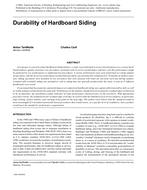Description
In response to concerns about hardboard siding failures, a study was performed to assess if performance in a current hardboard industry quality assurance test procedure correlated with in-service performance and how well this performance might be predicted by use of alternative or additional test procedures. A variety of laboratory tests were performed on a large number of specimens, and the in-service performance of matched specimens was periodically evaluated over 38 months of outdoor exposure. Siding specimens were installed on two test fences that were sprayed with water for one hour each day during summer. Commercially available siding was included as well as siding that was specially produced for the study. A total of 13 different hardboards were tested.
It was found that the properties and performance of commercial hardboard siding vary appreciably from mill to mill, as well as within samples of board from the same mill. Performance in the industry standard test procedure for residual edge swell proved to be an imperfect, but nonetheless useful, indicator of some performance characteristics on the test fences. With appropriate pass-fail criteria, the standard test for residual edge swell may be used to limit the likelihood of in-service failures, in particular, edge welting, surface mildew, and cracking of the paint on the drip edge. The authors also believe that the standard would be more meaningful if it included statistically based procedures that would ensure, at a specific level of confidence, that a product would meet the standard’s performance requirements.
Citation: Thermal Performance of Exterior Envelopes of Whole Buildings IX
Product Details
- Published:
- 2004
- Number of Pages:
- 12
- File Size:
- 1 file , 4.8 MB
- Product Code(s):
- D-BldgsIX30




